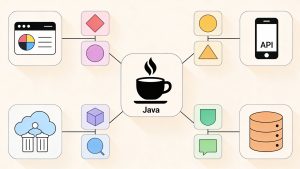Java Full-Stack Development is one of the most in-demand skills in software development today. A Full-Stack Java Developer is proficient in both frontend and backend technologies, allowing them to build complete web applications. They handle everything from designing interactive user interfaces to managing databases and server-side logic.
With Java being one of the most widely used programming languages, it provides robust frameworks like Spring Boot for backend development, while frontend frameworks like React.js and Angular enhance user experience. By mastering both aspects of development, Java full-stack developers can create scalable, efficient, and secure applications.
In this blog, we will explore what a Java Full-Stack Developer does, their key skills, the best frameworks to use, and some hands-on coding examples to help you get started.
What Is a Java Full-Stack Developer?
A Java Full-Stack Developer is a software engineer skilled in both frontend and backend development, enabling them to build complete web applications from start to finish. Unlike specialized developers who focus solely on either the frontend or backend, full-stack developers handle the entire application lifecycle, from designing user interfaces to managing servers and databases.
What Does a Full-Stack Java Developer Do?
To be proficient in Java full-stack development, one must have expertise in the following key areas:
1. Frontend Development
The frontend is the part of the application that users interact with directly. A Java Full-Stack Developer must be well-versed in:
- HTML (HyperText Markup Language): The backbone of web pages, used for structuring content.
- CSS (Cascading Style Sheets): Responsible for styling the user interface, ensuring a visually appealing experience.
- JavaScript: The scripting language that adds interactivity to web pages.
- Frontend Frameworks: Modern JavaScript frameworks like React.js, Angular, or Vue.js are commonly used to build dynamic, component-based user interfaces.
2. Backend Development
The backend is where the application’s business logic and data processing happen. A Java Full-Stack Developer should be proficient in:
- Java: The core programming language used for backend development, known for its robustness and scalability.
- Spring Boot: A popular Java framework for building REST APIs and microservices.
- Hibernate: A Java-based ORM (Object-Relational Mapping) tool used for database interactions.
- RESTful APIs: APIs that allow communication between the frontend and backend using HTTP requests.
3. Database Management
Databases store and manage the application’s data. A Java Full-Stack Developer must understand:
- SQL Databases: Structured databases like MySQL and PostgreSQL that use relational tables.
- NoSQL Databases: Non-relational databases like MongoDB, which store data in JSON-like documents.
- Spring Data JPA: A framework for simplifying database interactions in Java.
4. DevOps & Deployment
Beyond development, Java Full-Stack Developers are often responsible for deploying and maintaining applications in production. Key DevOps skills include:
- CI/CD Pipelines: Automating code integration, testing, and deployment using tools like Jenkins or GitHub Actions.
- Docker & Kubernetes: Containerization and orchestration for scalable applications.
- Cloud Services: Deploying applications on platforms like AWS (Amazon Web Services), Google Cloud, or Azure.
- Version Control: Managing source code using Git and repositories like GitHub or GitLab.
Let us look at an example of how a Java Full-Stack Developer structures a simple web application.
Full-Stack Java Developer Skills
Frontend Technologies: React.js Example
Frontend developers use React.js or Angular to create dynamic user interfaces. Here’s a simple React.js example that fetches and displays user data from a Java backend API.
jsx
import React, { useEffect, useState } from "react";
const UserList = () => {
const [users, setUsers] = useState([]);
useEffect(() => {
fetch("http://localhost:8080/api/users") // Calls the Java API
.then(response => response.json())
.then(data => setUsers(data));
}, []);
return (
<div>
<h2>User List</h2>
<ul>
{users.map(user => (
<li key={user.id}>{user.name} - {user.email}</li>
))}
</ul>
</div>
);
};
export default UserList;This React.js component fetches data from a Java Spring Boot backend and displays it dynamically.
Backend Development with Java Spring Boot
The backend API should be written in Spring Boot. Below is a simple REST API that returns a list of users.
java
@RestController
@RequestMapping("/api/users")
public class UserController {
@GetMapping
public List<User> getUsers() {
return List.of(
new User(1, "John Doe", "john@example.com"),
new User(2, "Jane Smith", "jane@example.com")
);
}
}
And the corresponding User model:
java
public class User {
private int id;
private String name;
private String email;
public User(int id, String name, String email) {
this.id = id;
this.name = name;
this.email = email;
}
public int getId() { return id; }
public String getName() { return name; }
public String getEmail() { return email; }
}Database Management with Spring Data JPA
Java Full-Stack Developers often use Spring Data JPA to manage database operations. Below is an example of a UserRepository that interacts with a MySQL database.
java
@Repository
public interface UserRepository extends JpaRepository<User, Long> {
}
The corresponding User entity:
java
@Entity
@Table(name = "users")
public class User {
@Id
@GeneratedValue(strategy = GenerationType.IDENTITY)
private Long id;
private String name;
private String email;
// Getters and Setters
}5 Top Java Full-Stack Frameworks
1. Spring Boot + React.js
- Spring Boot simplifies backend development with built-in features for REST APIs, security, and database management.
- React.js is a component-based JavaScript library used for interactive user interfaces.
2. Spring Boot + Angular
- Spring Boot handles backend logic, while Angular offers a structured framework for building frontend applications with TypeScript.
3. MEAN Stack with Java Backend
- A modified MEAN Stack replaces Node.js with Spring Boot for a Java backend. MongoDB, Express.js, and Angular remain for database and frontend development.
4. LAMP Stack with Java
- A traditional LAMP stack (Linux, Apache, MySQL, PHP) can be modified by using Spring Boot instead of PHP, allowing Java developers to manage backend services efficiently.
5. Django + Java (Hybrid Full-Stack)
- Django (Python) is often paired with Spring Boot for microservices-based full-stack applications, leveraging the strengths of both languages.
What Is the Difference Between Java and Java Full-Stack?
| Java Developer | Java Full-Stack Developer |
| Focuses only on backend development | Works on both frontend and backend |
| Uses Spring Boot, Hibernate for APIs | Uses React.js, Angular for UI |
| Primarily works with databases | Integrates frontend, backend, and databases |
| Does not handle UI design | Handles full application lifecycle |
Full-Stack Java Project Example
Now, let’s combine all these components into a simple Java Full-Stack application.
Backend: Spring Boot REST API
java
@RestController
@RequestMapping("/api/tasks")
public class TaskController {
@Autowired
private TaskRepository taskRepository;
@GetMapping
public List<Task> getTasks() {
return taskRepository.findAll();
}
@PostMapping
public Task createTask(@RequestBody Task task) {
return taskRepository.save(task);
}
}Frontend: React.js Fetching API Data
jsx
import React, { useEffect, useState } from "react";
const TaskList = () => {
const [tasks, setTasks] = useState([]);
useEffect(() => {
fetch("http://localhost:8080/api/tasks")
.then(response => response.json())
.then(data => setTasks(data));
}, []);
return (
<div>
<h2>Task List</h2>
<ul>
{tasks.map(task => (
<li key={task.id}>{task.title}</li>
))}
</ul>
</div>
);
};
export default TaskList;This full-stack project allows users to create and fetch tasks using Spring Boot on the backend and React.js on the frontend.
Conclusion
Java Full-Stack Development is a valuable skill set that allows developers to build complete web applications. By mastering Spring Boot for backend, React.js or Angular for frontend, and database management with SQL/NoSQL, developers can create powerful applications.
This blog explored the key responsibilities of a Java Full-Stack Developer, covered essential frameworks, and provided coding examples to help you get started. If you’re looking to break into full-stack development, start by building simple projects, learn modern frameworks, and practice integrating frontend and backend systems.
By becoming a proficient Java Full-Stack Developer, you open up exciting opportunities in the software industry, where full-stack expertise is highly valued.



